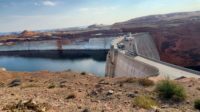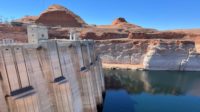Within two years, by 2023, ongoing drought in the Western U.S. could impact the ability of a major Arizona powerplant to supply electricity to millions of people across seven states, says the U.S. Bureau of Land Reclamation.
The projection comes as the U.S. Energy Dept.'s Energy Information Administration points to the worsening drought in its short term energy outlook that expects domestic hydropower output to fall 14% this year over 2020, with a 12% drop seen in the Columbia River Basin and several other states, and a 49% decline expected in California
The outlook from the bureau, part of the U.S. Interior Dept., shows the increasing likelihood over the next two years that water level in Lake Powell on the Arizona-Utah border could fall below what is needed for the 1.3 GW Glen Canyon Powerplant to generate electricity, the agency said Sept. 22
It anticipates there is a 3% chance that water in Lake Powell will drop below the minimum level needed to run the hydroelectric powerplant’s generators in 2022, and a 34% chance of that happening in 2023.
The plant, which includes eight generators inside the 710-ft-tall, 1,560-ft-long Glen Canyon Dam in northern Arizona, produces 5 billion kilowatt-hours of power each year, helping supply about 5.8 million utility customers in Arizona, Colorado, Nebraska, Nevada, New Mexico, Utah and Wyoming, according to the bureau.
Lake Powell, which was created by the dam, is the second-largest U.S. reservoir, holding more than 26 million acre-ft of water, a level reached in 1980.
However, the actual amount of water stored in it can fluctuate each year. In July 2021, decreased water flowing into the lake—forecast for the year at just 30% of the average amount— brought its level to a record low and prompted the bureau to schedule release of an additional 181,000 acre-ft of water from up river to Lake Powell between then and December.
“The latest outlook for Lake Powell is troubling,” said Wayne Pullan, bureau Upper Colorado Basin regional director, in a statement.
Even with the extra water releases, the latest federal projections show the chances of Lake Powell dropping below the minimum level for powerplant operation remain elevated at 25% in 2024, 28% in 2025 and 34% in 2026.
The Western Electricity Coordinating Council, a nonprofit corporation responsible for bulk power system reliability and security in much of the West, said it conducts system adequacy and system stability planning studies to help its members plan for any major issues.
The powerplant isn’t the only issue.
Lake Powell is part of the Colorado River Storage Project, which provides irrigation water to farms and municipal water to communities across the seven states. A drop in water level also means less water to release down river. Water from the lake flows down the Colorado to Lake Mead, behind the Hoover Dam.
In August, bureau officials said Lake Mead was facing a water shortage for the first time ever, prompting water use restrictions for 2022.
The situation may not be improving soon. A recent National Oceanic and Atmospheric Administration Drought Task Force report found record low precipitation across much of the Southwest between January 2020 and August 2021. The report states that several years of above-average rain will be needed to replenish rivers and reservoirs across the region, and predicts the drought will last at least into 2022, and potentially longer.
Tom Buschatzke, director of the Arizona Dept. of Water Resources, said in a statement that the new projections show the need for action beyond current drought contingency plans for the entire Colorado River system.






Post a comment to this article
Report Abusive Comment